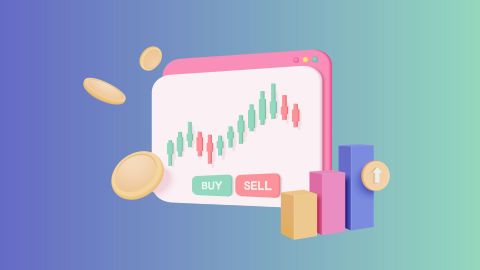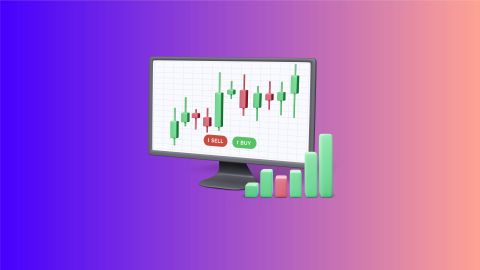Volume is an indicator that means the total number of shares traded within a defined timeframe or throughout a trading session. It involves both the buying and selling activities of every share within the specified period.
What is trading volume?
Trading volume represents the total number of shares traded within a given time period in the stock market. This includes all buy and sell transactions. For instance, if 200 shares of a company are bought and later sold during a single trading day, the total trading volume for that stock would amount to 400, as each transaction—whether a purchase or a sale—is counted.
In simple terms, trading volume reflects the overall activity surrounding a stock. Higher volumes indicate significant trading activity, while lower volumes suggest reduced market interest.
This concept extends beyond stocks and applies to various financial instruments such as bonds, derivatives, futures, options, gold, and other commodities. Stock exchanges routinely report trading volumes for individual stocks and the entire market for each trading session. Additionally, trading volumes can be assessed for indices, such as the Nifty 50 or Sensex, over specific timeframes.
By evaluating trading volumes, investors and traders can better understand market activity, liquidity, and the level of interest in particular stocks or instruments.
Where can you find trading volume?
Trading volumes of stocks are readily available across all stock market exchanges. Information on the volume of any particular share can be easily accessed through exchanges, news websites, and third-party platforms providing stock market data. Additionally, investors can inquire about trading volumes through brokers and investment platforms. Candlestick charts utilised by platforms display volumes for specific timeframes, with green bars indicating buying volumes and red bars representing sell volumes. Volume charts, ranging from hourly to monthly and 200-day periods, offer insights into trading activities. Discrepancies in trading volumes between exchanges like NSE and BSE can result in slight price variations, particularly for stocks listed on both platforms.
What does trading volume indicate?
Trading volume reflects the level of activity surrounding a specific stock by recording every buying and selling transaction. It serves as a measure of market interest and activity.
- High trading volume signifies a heightened level of activity and interest in a stock. This could stem from either positive developments, such as strong earnings reports, or negative events, such as adverse news triggering increased selling.
- Low trading volume indicates less interest or activity in a stock, often suggesting limited buying or selling.
In broader terms, trading volume is a measure of market activity and liquidity. Liquidity refers to how easily investors can buy or sell a stock without impacting its price. Higher volumes indicate greater liquidity, as more buyers and sellers are actively participating in the market.
Within a trading day, volumes are generally higher during the opening and closing sessions. This is because intraday traders tend to execute or finalise their trades at these times. Analysing trading volume is particularly useful for short-term traders who rely on these metrics to identify opportunities.
Trading volume is also a valuable tool for long-term investors using fundamental analysis. It can help confirm significant price movements over time, offering insights into the strength and sustainability of market trends.
Importance of volume in the share market
Volume plays a critical role in understanding market sentiment and informing trading decisions. Here's a breakdown of its significance:
1. Indicator of market interest
Volume reflects the level of investor activity in a particular stock. High volume suggests a strong interest in the stock, either from buyers pushing the price up or sellers driving it down. Conversely, low volume can indicate a lack of conviction or indecisiveness among investors.
For example, if a company announces positive earnings and the stock price surges alongside a significant increase in volume, it suggests investors are excited about the company's future prospects and are actively buying shares. Conversely, a price drop accompanied by low volume might indicate the price movement is temporary and lacks strong conviction from investors.
By analysing volume alongside price movements, traders can gauge the underlying strength or weakness behind a price trend. High volume confirms a significant price move, while low volume can suggest a potential reversal or a less sustainable trend.
2. Indicator of liquidity
Liquidity refers to how easily an asset can be bought or sold at a fair price. Volume is a key indicator of liquidity. High volume suggests a deep market with many potential buyers and sellers, making it easier to enter and exit positions without significantly impacting the price. Conversely, low volume can indicate a thin market with fewer participants, potentially leading to larger price swings when even small buy or sell orders are placed.
For investors, trading in high-volume stocks is generally preferred as it allows them to buy and sell positions quickly and efficiently with minimal impact on the price they receive.
3. Finding volume on a chart
Most stock charts display volume along the bottom axis. It's typically represented by bars or lines. The height of the bar or the thickness of the line corresponds to the trading volume for that specific time period (e.g., minute, hour, day). By analysing the volume bars or line over time, you can identify periods of high or low trading activity.
Some charting platforms offer additional volume indicators, such as the On-Balance Volume (OBV), that analyse volume changes in relation to price movements to provide further insights into market strength.
4. Relation of volume and price
Volume and price are interconnected. In a healthy market, there's usually a correlation between volume and price movements. Significant price changes are often accompanied by high volume, indicating strong buying or selling pressure. Conversely, smaller price movements tend to occur during periods of low volume.
However, the relationship between volume and price isn't always straightforward. For instance, a sudden spike in volume with a small price movement might indicate buying or selling pressure that hasn't yet been fully reflected in the price. Conversely, high volume accompanying a small price change could be a sign of order book exhaustion, suggesting the price movement might not be sustainable.
By analysing volume alongside price movements and other technical indicators, traders can make more informed decisions about entering or exiting trades.
Volume in technical analysis
Volume is an integral component of technical analysis, a methodology used to forecast future price movements based on historical market data. Technical analysts examine volume patterns alongside price charts to identify trends, reversals, and trading opportunities.
One commonly used technical indicator related to volume is the volume weighted average price (VWAP). VWAP calculates the average price of a security weighted by trading volume over a specified time period. Traders use VWAP to assess whether they are buying or selling at prices better than the average market participant.
Volume can also be analysed through other technical indicators such as the on-balance volume (OBV), Accumulation/Distribution Line, and volume oscillator. These indicators help traders assess the strength of buying or selling pressure in the market and identify potential trend reversals.
Volume and price: How are they related or unrelated?
Volume and price are closely intertwined in the stock market. While they often move in tandem, there are instances where they may diverge, leading to important insights for traders and investors.
In a typical scenario, rising prices accompanied by increasing volume suggest strong bullish momentum, indicating widespread buying interest in the market. Conversely, declining prices coupled with high volume indicate strong bearish sentiment, signalling widespread selling pressure.
However, there are situations where volume and price may exhibit contradictory movements. For example, declining prices on low volume may indicate a lack of conviction among sellers, potentially signalling a reversal or consolidation phase in the market. Similarly, rising prices on decreasing volume may suggest weakening momentum and potential exhaustion of the prevailing trend.
It is essential for traders and investors to analyse volume-price dynamics with other technical and fundamental factors to make well-informed decisions in the stock market.
Conclusion
In conclusion, volume is a vital metric in the Indian securities market, reflecting the level of trading activity and liquidity. Understanding volume patterns and their relationship with price movements is crucial for traders and investors seeking to navigate the complexities of the stock market. By incorporating volume analysis into their trading strategies, market participants can gain valuable insights into market sentiment and identify potential trading opportunities.
Related Articles
What is forex trading
What is intraday trading
Know about option trading strategy
What is margin trading
What is swing trading indicators




